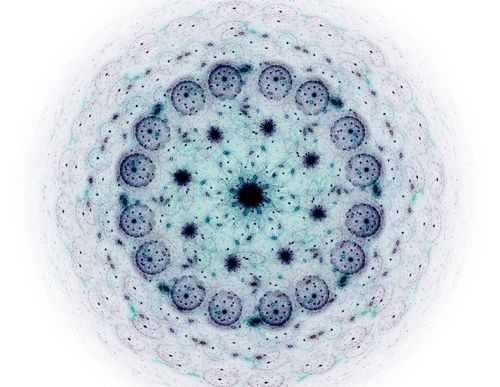What shape is your carpet?

The things that we are going to talk about in this article belongs to a class of mathematical objects called Fractals. Mathematically a fractal is a set that produces repeating patterns at every scale. Meaning, if you zoom in a particular region of the pattern, the smaller region will have same structure or pattern as the larger one. For example, one can talk about the Cantor set, which is all about deleting the open middle thirds of a line segment recursively.

Cantor Set
Take the segment to be the interval . Then delete the open middle third
from
.
That’ll leave us with the line segment . Then next, the open middle thirds of each of these segments deleted, we get the segments
, four of them. Repeating this process ad infinitum will give us the adjoining figure.
Now from a point of view of geometry, consider an equilateral triangle. Subdivide it into four smaller congruent equilateral triangles and remove the middle one. That’ll leave with three smaller triangles. Again subdivide the smaller triangles into four smaller equilateral triangles and then delete the middles ones from each section. Repeat the process. What results in is called a Sierpinski triangle, named after the Polish mathematician Waclaw Sierpinski, who studied them.

Sierpinski Triangle
The interesting thing about Sierpinski triangle is that it has infinite number of edges but zero area. For, it starts with three sides. After the first iteration, it rises to nine, that is . After
iterations, the number of edges will be
. But the area decreases with each iterations. After the first iteration, we lose the area by an amount
, so the remaining area is
. So after
th iteration, the area will be
. Taking limit,
as
.
Let us try the above construction process with another figure, say a square. Divide the square into nine smaller squares, then remove the middle square. It will give a two dimensional version of a square doughnut. Then again subdivide each small squares into nine smaller squares and then remove the middles square from each of these squares. Repeat the process. We will get the following figure.

What we get is known as Sierpinski carpet. Like Sierpinski triangle, area of Sierpinski carpet is zero, as after each iteration the area remains is th of original area. Arguing like above we can show that the area tends to zero as the number of iterations tends to infinity. Another interesting property of Sierpinski carpet is that it’s interior is empty. For, if there is a point say
interior to the carpet, then there will be a square with the center at
, contains entirely inside the carpet. But as the iterations repeated to ad infinitum, at some step (say
th), the square will be holed. Hence a contradiction.
Until now, we are talking about these amazing things in two dimension only. Let’s move one step up and see how things changes in three dimensions. The three dimensional generalization of Sierpinski carpet is known as Menger sponge, named after Karl Menger, an Austrian-American mathematician who first described them in 1926.
In case of Menger sponge, we consider a cube rather than a square and subdivide each face into nine smaller cubes like a Rubik’s cube, with a total of smaller cubes. Then remove the middle ones from each faces and repeat the process for the rest of the smaller cubes.
 Like it’s two dimensional counterpart, Menger sponge has zero volume but an infinite surface area. So as the iterations increases, the Menger sponge started to become invisible yet holds an infinite surface area. Menger sponge is an incredible object with counter-intuitive properties. So why not try to build one and see what it looks like in real. This is where the Japanese origami art comes handy.
Like it’s two dimensional counterpart, Menger sponge has zero volume but an infinite surface area. So as the iterations increases, the Menger sponge started to become invisible yet holds an infinite surface area. Menger sponge is an incredible object with counter-intuitive properties. So why not try to build one and see what it looks like in real. This is where the Japanese origami art comes handy.
To build a small square, fold some business cards (actually of them) shown in the picture below.


Jeannine Mosely

Matt Parker
Add 20 of those to build the first stage. Then for stage 2, you need 20 stage one Menger sponge glued together and so on. You will need roughly business cards to make a level
Menger sponge. Jeannine Mosely, a Ph.D holder from MIT, built a level
Menger sponge using
business cards and with the help of
volunteers. The project took 10 years.
Matt Parker of Queen Mary University of London has started a project called MegaMenger to build the largest fractal structure, a level Menger sponge. They have already built
level
Menger sponge with the help of volunteers around the world and all that remains is to assemble them.
Featured Image Courtesy: Shutterstock